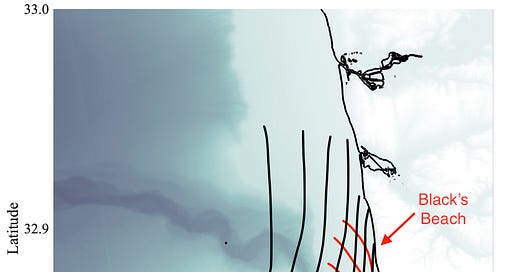Consider Nazaré in Portugal, home to some of the biggest waves ever surfed, or Blacks Beach in San Diego. These legendary spots sit adjacent to large underwater canyons, and it's no coincidence that they catch oversized swells compared to neighboring breaks.
Now, conventional wisdom might suggest that these canyons act like giant funnels, channeling waves directly to the shore. However, the truth is quite the opposite. Swells, it turns out, aren't fond of canyons and actually avoid them due to the phenomenon we covered in a previous article - refraction .
As swells approach the coast, they begin to interact with the seafloor. The portions of the wave traveling over shallower water slow down more than the parts over deeper water. This differential in speed causes the wave to bend towards the shallower areas, which we described as a shopping cart with a janky wheel pulling to the janky side. The canyon, being significantly deeper than the surrounding seafloor, acts more like a barrier that waves tend to get pushed away from rather than converge in.
At spots like Nazaré and Blacks, this results in waves from multiple directions meeting in one area, combining their energy to create larger, more powerful waves. It's a bit like a natural version of what happens at jetties, where waves reflect off the structure and combine with incoming swells. However, in this case, rather than pure reflection, the underwater canyon gently steers the swell energy, and combines the energy with the other incoming swell.
This steering effect can lead to some truly spectacular wave formations. As the swell energy is redirected and concentrated by the canyon, it can create steep, powerful waves that seem to rise out of nowhere. At Nazaré, for instance, the underwater canyon extends far out to sea, allowing it to influence swells long before they reach the shore. This extended interaction time results in waves that can reach staggering heights, sometimes topping 100 feet.
But it's not just about size. The way canyons shape waves can also create unique wave characteristics. At Blacks Beach, the north fork of the submarine canyon helps create the spot's famous A-frame peaks. This happens because the canyon redirects swell energy to a single point and this point peaks up and breaks from there.

Underwater canyons significantly affect wave formation, but also the local biology. These areas are known drivers of mixing and upwelling. It is also not a coincidence that a large great white population can be tracked to Torrey Pines, just outside of the canyon. These bitey lads are drawn to the area's rich biodiversity, which is directly linked to the canyon's influence on local oceanography.
As climate change alters ocean currents and sea levels, the influence of underwater canyons on coastal processes may evolve with them. Understanding these complex systems is crucial not just for surfers chasing mountains, but for coastal communities adapting to a changing ocean. Whether you're charging XXL days or watching from the cliffs, remember that the canyon shaping those waves isn't directly beneath you, but its influence is undeniably present in every monster set that rolls through.
Further Reading:




Very cool! I wrote about Nazaré for Nautilus magazine a couple of years ago. We spoke with UCSD oceanographer Falk Feddersen as well as with Brazilian big wave surfer Maya Gabeira for the story. https://nautil.us/how-it-feels-to-surf-the-worlds-biggest-wave-245476/